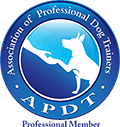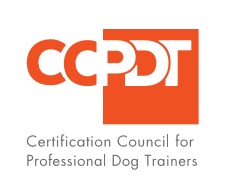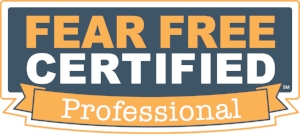Archived OLDT :: Hand Targeting
So much more than just a trick...
Who says training can't be fun and entertaining as well as essential?! Training a behavior that can install an important obedience command, counter-condition a shy dog, and be shaped into tricks besides is truly a gem!
Hand-targeting refers to your dog touching or targeting your flat palm with her nose. What are the advantages to installing such a behavior?
- First and foremost, it can offer a very reliable "come". If your dog is used to getting a very lovely treat for flying across the room and touching her nose to the palm of your hand, then you have a very strong contingency plan should you accidentally drop the leash on the street and need to get your dog to return to you.
- If your dog is a robust greeter, perhaps a little too robust for the comfort of some visitors, having your dog "say hi" by touching her nose to the visitor's hand and then return to you for a treat is a great way to redirect her energies.
- Alternatively, if your dog is hand-shy, making the hand a predictor of good things is a great way to get her more comfortable with the presence of hands in her airspace. And if she's shy around new people or visitors, she can "say hi" and then return to the comfort of your side for her treat.
- Once you can lead your dog through space with your hand, you can steer your dog through a series of fairly impressive tricks, like "jump", "tippy-toes", and "spin".
Installing the Command
For a jumpstart, rub your pup's favorite treat on the palm of your hand, just to leave a bit of its aroma there. Now put your flat palm right next to one side of her nose. Invariably, out of curiosity, she will turn her head to sniff your hand. At the very instant that her nose touches your hand, say "yes!" or "good!" in a happy voice and give her a little piece of treat from the other hand. Repeat this, not demanding any distance, but just putting your hand right next to her nose.
At some point, something will click for your dog. You'll notice that she starts to turn intentionally and firmly plant her nose on your palm. Then you know she's made the connection -- touching the hand earns her a treat. At this point, up the ante a bit. Place your hand a foot away from her, making her move to reach it. Then start moving your hand around, and moving yourself about the room.
When you have a reliable behavior, meaning that you would just about bet your life that, if you put your hand out, your dog would touch it, it's time to introduce a verbal command like "touch". Give the command, then put out your hand. You want the word "touch" to become the predictor that a hand will be offered.
Making It Fun
Now, with the help of a training partner, each of you stocked with the same treats, have the dog tag back and forth between you as you both move about. It becomes a very fun game -- it will firmly install the touch behavior and your dog will enjoy the active aspect of this game!
Common Problems
- If your pup is concentrating on your treat hand rather than your flat hand, then put it behind your back to lessen its distraction.
- If she is ignores your hand, then remove it, wait a few seconds, and offer it again. Your hand is the "button" -- it is her only opportunity for a treat -- so if she's not responding to it, then she temporarily loses access to it. Sometimes making movements with your hand, such as arcing it away from her, will attract her to it and remind her of its presence.
- Whatever you do, don't move the hand toward her or touch your hand to her nose. If she is not making the choice herself to touch it, she will not learn that that choice is what's earning her the treat.
- Your dog might, in her impatience, do a fly-by, not quite touching your hand. If you're just at the beginning of installing the behavior and it's been a bit slow in getting started, then you might consider this acceptable. However, as she masters the behavior, sloppy touches should not be reinforced -- no touch, no treat!
- Limit yourself to sessions that are 5 minutes or so. It's better to do several short sessions than one long session. You want to quit before she's tired of the exercise and before she's full. Leave her wanting more.
Tricks for Treats
Say Hi: Once your dog is consistently touching her nose to your open palm, have another person place their open palm at your side. You give the verbal cue "say hi", and then you mark the behavior with a "yes!" or "good!" as soon as the touch happens. Then offer her a treat. Gradually have your training partner move farther away from you. You give the command "say hi", which means to your dog to look around for a hand to touch, verbally mark the behavior as she touches your partner's hand, and then you offer the treat.
Now both you and your training partner can stock up on treats, stand a few feet apart, and send the dog back and forth between you. Each handler sends the dog to the other's hand by saying "say hi", then marking and treating.
Jump: Hold your leg out in front of you (at a height appropriate for your dog) and hold your open palm above your leg. As your dog moves toward it, arc your hand over your leg and away from your dog. This will lead her spatially over your leg. If you'd like, you can precede the hand prompt with the verbal cue "jump".
At some point, the sight of your leg will become your dog's cue for jumping and you will no longer need to lead her over your leg.
Tippy-Toes: Hold your open palm steadily above your dog's head, at a height which she can touch by standing on her hind legs. If you'd like, you can precede the hand prompt with the verbal cue "tippy toes".
Spin: With your dog in front of you, hold your open palm at your dog's nose height. Lead her around in a tight circle. If you'd like, you can precede the hand prompt with the verbal cue "spin".
Some Final Tips
- It's all in the timing! Make sure that your verbal reinforcement ("yes!" or "good!") happens exactly when your dog's nose touches your hand. This is the marker that tells her that the nose touch is precisely the behavior you're looking for. The timing of the delivery of the treat is not as important.
- Soft treats are best for the purpose of training. They're more easily chewed and, since you want a quick succession of reps, the faster each treat is chewed, the better.
- Make sure you're using small pieces for treats. You don't want your dog to fill up too quickly, and ten tiny treats are ten times better than one big treat from your dog's point of view. And it goes without saying... the smaller the dog, the smaller the treat.
- Make sure that the reinforcements you offer for this behavior are especially rewarding. Think of it this way... You're asking your exuberant greeter to return to your side despite the excitement of a visitor. You're asking your shy dog to be comfortable around strangers and around approaching hands. And you're relying on the magnetic power of your hand in those situations where you want to recall your dog from a distance. I'd wager that an investment of hot dogs, turkey cold cuts, even a nibble of left-over steak during the practice phases will leave you in good stead for the real thing!




